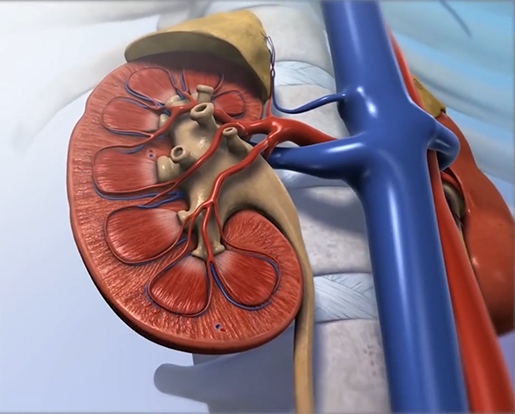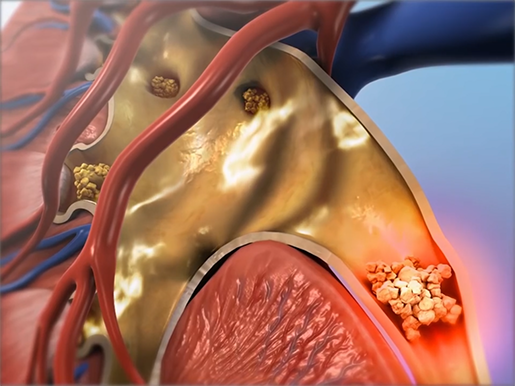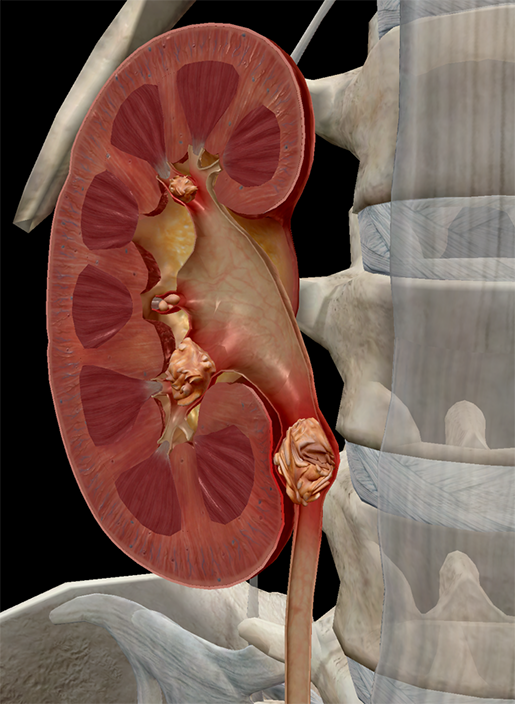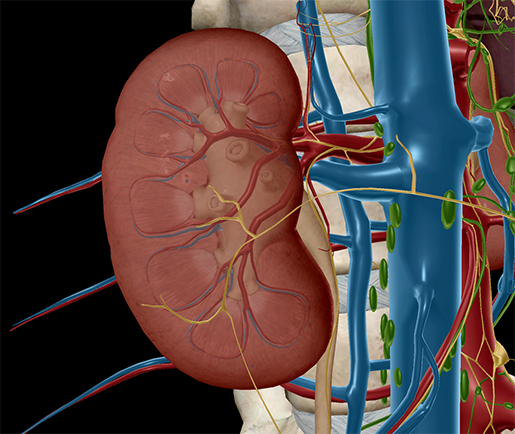Painful Pebbles: The Anatomy and Pathology of Kidney Stones
Posted on 9/14/17 by Marian Siljeholm
Those who haven’t suffered a kidney malady are officially banned from casting the first stones regarding this blog post (pun always intended).
I’ve never had kidney stones, however, I did have a kidney infection. While I’m aware that the two are certainly not the same, when I arrived at the ER doubled over in agony, the degree and geography of my pain caused my very patient nurse to first test for kidney stones, which gave me an idea of the severity of the pain apparently felt by the poor souls who do suffer the dreaded stones. Having shattered my tibia four years previous to this ER visit, I can honestly say that this was worse.
But what even are these exceptionally painful internal pebbles? Where do they come from? How can we get rid of them? All very good questions!
Let’s take a look.
 Image captured from Physiology Animations.
Image captured from Physiology Animations.
The kidneys, your body’s filtration system, are constantly busy removing extra fluids and waste products from your blood, which are then excreted as urine. Urine contains things like calcium, phosphate, oxalate, and uric acid. On good days, these substances are diluted so they flow through the urine easily, but if urine becomes concentrated or something changes the level of a substance in the urine, crystals can form and become lodged in kidney tissue and grow to become kidney stones.
Since I’ve always had impeccable timing, my infection hit not only at a time when I had never heard of a kidney infection, but also shortly after my arrival in a foreign country—a very rural region, at that. So when I began exhibiting the classic symptoms of a kidney malady, I did the worst possible thing possible and ignored it. Hopefully you never suffer a kidney affliction, dear reader, and if you do hopefully you aren’t in a foreign country far from a hospital or people who speak your native language; however, since my mother always said prepare for the worst and expect the best, here are some harbinger symptoms of dreaded stones to be aware of:
- Pain in the side or back, which then spreads to the lower belly and groin (especially if it comes and goes in waves)
- Blood in the urine
- Nausea, vomiting, as well as fever and chills
- The need to pee often or urgently
 Image captured from Physiology Animations.
Image captured from Physiology Animations.
Although kidney stones are an affliction typically reserved for adults, they can also affect teens and adolescents. Ranging in size (and type, yes there are multiple and we’ll get to that in a moment) from a fraction of an inch to several inches, kidney stones can pass easily if they’re small enough. Larger stones, on the other hand, can be quite painful because they block the flow of urine and cause other urinary tract problems if left untreated.
Not all pebbles are created equal. There are four major kinds of kidney stones, each with different causes and treatments:
- Calcium stones: The most common kind of kidney stone, these develop when calcium in the urine combines with other substances like oxalate or phosphate to form crystals.
- Uric acid stones: When too much uric acid forms in the pee it can crystallize and combine with calcium to form a stone.
- Struvite stones: The type likely to grow the largest, this type of kidney stone is made of a mineral called struvite, a combination of ammonium, magnesium, and phosphate.
- Cystine stones: This rare type of stone can form if someone has too much of an amino acid called cystine.
 Image from Physiology & Pathology.
Image from Physiology & Pathology.
Treatment is based on type and size of the stone. Some patients may just need to drink lots of water and take medicine to reduce pain or the levels of crystal-forming substances in the urine. In more severe cases surgery may be necessary, especially if a stone has become too large to move and causes a blockage resulting in hydronephrosis, or swelling within the kidneys resulting from a urine backup.
In terms of causation the jury is still somewhat out, but the verdict seems pretty clear that an unhealthy or especially sodium-rich diet, chronic dehydration, as well as certain medicines, metabolic disorders, or genetic conditions, and chronic urinary tract problems elevate one’s chance of developing kidney stones. Effective prevention methods are similarly unclear, however, given that dehydration is a large risk factor, staying hydrated is the best deterrent. If your urine runs clear, you’re in the clear.
Sorry, TMI? On the Visible Body Blog, there's no such thing as TMI.
 Image from Human Anatomy Atlas.
Image from Human Anatomy Atlas.
I never suffered the dreaded stones, it’s true, and I will not pretend to understand the agony experienced of those who have. That said, my very painful and vaguely traumatizing bout with a kidney affliction left me with one lesson that will remain with me forever: don’t mess with them.
______________________________________________________
Be sure to subscribe to the Visible Body Blog for more anatomy awesomeness!
Are you a professor (or know someone who is)? We have awesome visuals and resources for your anatomy and physiology course! Learn more here.
Related Posts:
The Visible Body Learn Site: The Urinary System
The Visible Body Learn Site: The Functions of Blood
Additional Sources:
“Kidney Stones.” Edited by Robert S. Mathias, KidsHealth, The Nemours Foundation, Oct. 2016, kidshealth.org/en/teens/kidney-stones.html#.






